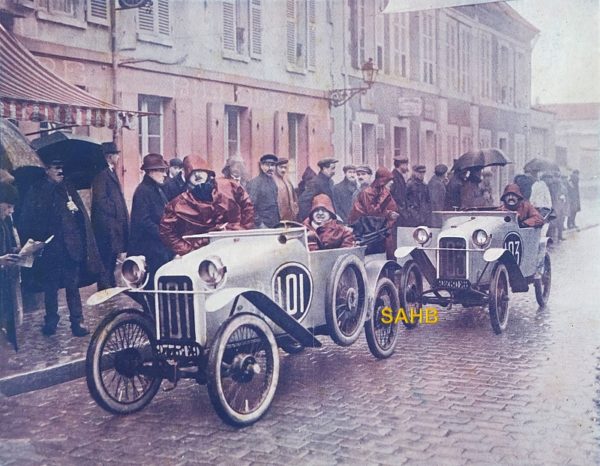
- This colourised photograph was taken on 17 February 1923 at Sens, 125km southeast of Paris, during the 1923 Paris-Nice race for motorcycles and cyclecars. The official name of the race was rather more exotic: “Le Critérium International de Tourisme Paris-Nice”. The French word critérium has been defined by Merriam-Webster as “a bicycle race of a specified number of laps on a closed course over public roads closed to normal traffic” but was applied to many different races at the time.
The caption to the photograph is full of fascinating details, at least some of them doubtless to repay the generosity of the various companies who had provided parts and equipment – and not just the obvious tyres, oil and spark plugs. It is therefore worth translating in full:
“BENJAMIN TRIUMPHS IN THE PARIS-NICE
The International Touring Car Competition has been the occasion for the latest success for the Benjamin company. The three vehicles entered by them were classed first equal, with no penalties, in the 750cc cyclecar category, winning 3 gold medals. Seen here are two Benjamins at the Sens control.
(Persan tyres. – Castrol oil. – R.E.A. carburettors. – S.A.G.A. magnetos. – Platel spark plugs. – Técalemit lubrication. – Hartford shock absorbers. – Fabrikoïd upholstery. – Waterproof jackets by the House of Persan.)”
The drivers’ names were given in a post-race Benjamin advertisement as Mme Violette Morris, Lenfant and Hibert. The first-named was a remarkable if notorious woman: a French athlete and a successful racing driver, she won two gold and one silver medal at the Women’s World Games in 1921–1922. To find out the source of her notoriety and her eventual fate, we recommend a short detour to Google. There is far too much to cover in this Snapshot.
The Benjamin firm was established by Maurice Jeanson in Asnières in 1921. He started with a range of cyclecars, identified as the Benjamin Types A, B and C. The Type A, although powered by a 4-cylinder unit of 751cc and with shaft drive, just managed to keep under the 350kg limit for the favourable tax treatment available to cyclecars. The Type B used a 2-cylinder 547cc engine, while the Type C was a sporty version of the Type A, its 4-cylinder engine increased to 817cc.
The engine size and number of cylinders of the cars in our Snapshot are unknown, but the cars look to be conventional 4-cylinder machines, possibly sleeved down to get under the 750cc limit for their category.
After dabbling with several 2-stroke models with limited success, Benjamin returned to 4-cylinder 4-strokes with Chapuis-Dornier or Ruby engines. In 1927 the company was restructured and renamed as Benova. A rapid rise in consumer incomes during the mid-1920s brought the cyclecar era to an end, and Benova moved into the production of standard-sized cars – even one powered by a small 1502cc S.C.A.P. 8-cylinder engine. The company ceased business in 1931.
Photo courtesy of The Richard Roberts Archive.







Leave a Comment